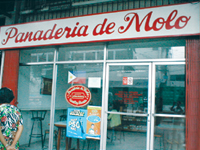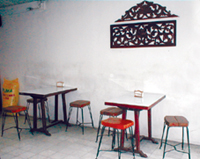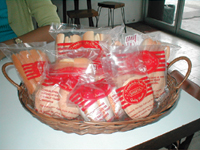 Like an oasis amidst the desert, The Mango Tree Bar and Restaurant in Mandurriao provides a respite for Ilonggos who are tired and weary of the concrete jungle Iloilo City is fast becoming. Hidden in plain sight along Guzman Street, this restaurant was so named for the mango tree that provides the perfect centerpiece in the al fresco dining area.
Like an oasis amidst the desert, The Mango Tree Bar and Restaurant in Mandurriao provides a respite for Ilonggos who are tired and weary of the concrete jungle Iloilo City is fast becoming. Hidden in plain sight along Guzman Street, this restaurant was so named for the mango tree that provides the perfect centerpiece in the al fresco dining area.  From the street outside, if not for the signage that bears the bistro’s name, one might easily get lost for it mimics the surrounding residential area. Until one enters, he is transformed into another world – a gastronomical secret garden perhaps. The concrete jungle suddenly becomes green complete with the sights and sounds of nature. The lush greeneries and vines dangling down from trees compliment the sounds of the birds chirping and rustling of tress.
From the street outside, if not for the signage that bears the bistro’s name, one might easily get lost for it mimics the surrounding residential area. Until one enters, he is transformed into another world – a gastronomical secret garden perhaps. The concrete jungle suddenly becomes green complete with the sights and sounds of nature. The lush greeneries and vines dangling down from trees compliment the sounds of the birds chirping and rustling of tress. Before one gets lost in translation, he is reminded that he entered a restaurant by the glass-walled and air conditioned dining area. Homey yet elegant, the indoor area is seems a combination of both a dining and living rooms. Dining tables and chairs in them idle while comfortable lounges on the sides.
Before one gets lost in translation, he is reminded that he entered a restaurant by the glass-walled and air conditioned dining area. Homey yet elegant, the indoor area is seems a combination of both a dining and living rooms. Dining tables and chairs in them idle while comfortable lounges on the sides. But it’s what in the outside that beckons diner to venture out and complete “The Mango Tree” experience. A grassy lawn lined with different trees in the side with a mango tree dotting the center. Tables and chairs can be set up to one’s preference and tents provide extra protection from the sun’s rays that penetrate the foliage above.It’s like communing with nature first, then with what one actually came for – food.
But it’s what in the outside that beckons diner to venture out and complete “The Mango Tree” experience. A grassy lawn lined with different trees in the side with a mango tree dotting the center. Tables and chairs can be set up to one’s preference and tents provide extra protection from the sun’s rays that penetrate the foliage above.It’s like communing with nature first, then with what one actually came for – food.  The Mango Tree bistro, more than the ambiance it offers, is also a gastronomic destination this side of the city. Whether one is hungry and yearns for a good meal or perhaps just for a quick fix, this restaurant has a lot to offer its guests.
The Mango Tree bistro, more than the ambiance it offers, is also a gastronomic destination this side of the city. Whether one is hungry and yearns for a good meal or perhaps just for a quick fix, this restaurant has a lot to offer its guests. We were hungry that time so we ordered more than a quick fix. It a lot of time to order since most were first timers and some specialties were not available. Service was prompt yet some of our orders took long to be served but we didn’t complain - the surrounding was enough distraction for us to notice. And when it came, it was indeed a visual feast and as we all brought our cameras and started the usual clicks and flashes before we dig in.
We were hungry that time so we ordered more than a quick fix. It a lot of time to order since most were first timers and some specialties were not available. Service was prompt yet some of our orders took long to be served but we didn’t complain - the surrounding was enough distraction for us to notice. And when it came, it was indeed a visual feast and as we all brought our cameras and started the usual clicks and flashes before we dig in. The seafood paella served as our “rice” but already was a complete meal in itself. Everybody was surprised it wasn’t the usual yellow rice with toppings. Shrimps and squid sautéed with bell peppers in tomato sauce then mixed with cooked rice and garnished with hardboiled egg was their own version of paella. That’s quite literal as one can really see everything. It didn’t really stand out and just like I’ve said, “it served as our rice”.
The seafood paella served as our “rice” but already was a complete meal in itself. Everybody was surprised it wasn’t the usual yellow rice with toppings. Shrimps and squid sautéed with bell peppers in tomato sauce then mixed with cooked rice and garnished with hardboiled egg was their own version of paella. That’s quite literal as one can really see everything. It didn’t really stand out and just like I’ve said, “it served as our rice”. Another surprised was their chop suey – we thought we had the wrong order. Instead of expecting mélange of vegetables with meat or seafoods, a plate of crispy noodles topped with vegetables and assorted meats came. “Did anyone order crispy pancit canton?” we asked but it turned out that’s their version of chop suey. It was good “pancit” in the end but hoping for the usual chop suey next time.
Another surprised was their chop suey – we thought we had the wrong order. Instead of expecting mélange of vegetables with meat or seafoods, a plate of crispy noodles topped with vegetables and assorted meats came. “Did anyone order crispy pancit canton?” we asked but it turned out that’s their version of chop suey. It was good “pancit” in the end but hoping for the usual chop suey next time. The chicken bulgogi came with mixed vegetables and that served as my chop suey-lol. It was stir fried chicken pieces with oyster sauce and sesame seeds. It was salty for my taste, not that I’m sensitive but I tasted it even before the chicken touched my lips. Though Im not cook but it would have tasted better if they used sesame oil – I’m a fanatic. But if indeed they did, I didn’t catch its flavour and aroma.
The chicken bulgogi came with mixed vegetables and that served as my chop suey-lol. It was stir fried chicken pieces with oyster sauce and sesame seeds. It was salty for my taste, not that I’m sensitive but I tasted it even before the chicken touched my lips. Though Im not cook but it would have tasted better if they used sesame oil – I’m a fanatic. But if indeed they did, I didn’t catch its flavour and aroma. These fried calamares were perfect - crisp, flavourful and the dip it came with was just as well ….. perfect. It was among the first to be finished off and nothing was left except memories. The problem is, it’s just as good as any calamares I’ve tasted so it can’t really be a stand out for the restaurant. But it will still be part of order next time.
These fried calamares were perfect - crisp, flavourful and the dip it came with was just as well ….. perfect. It was among the first to be finished off and nothing was left except memories. The problem is, it’s just as good as any calamares I’ve tasted so it can’t really be a stand out for the restaurant. But it will still be part of order next time. The last to arrive (and ordered too) was the Buffalo wings and it came as if it was screaming”take a picture of me, I’m photogenic” and indeed it was. I haven’t got to taste the dip it came with for the chicken was already good on its own. Full of flavour but I wished those chili peppers weren’t just as garnishing but “blended” for an extra kick - I’ll request for it next time.
The last to arrive (and ordered too) was the Buffalo wings and it came as if it was screaming”take a picture of me, I’m photogenic” and indeed it was. I haven’t got to taste the dip it came with for the chicken was already good on its own. Full of flavour but I wished those chili peppers weren’t just as garnishing but “blended” for an extra kick - I’ll request for it next time.  Of the two specialty I eyed that time only the mango tree iced tea was available. It was a concoction of tea, green and ripe mangoes blended with ice so it literally was a frozen iced tea. The sweetness of the ripe mango played well with the green mango (maybe it was just almost ripe mango). The other specialty was the sizzling bulalo steak -it was a now show. My craving for it heightened after reading this feature.
Of the two specialty I eyed that time only the mango tree iced tea was available. It was a concoction of tea, green and ripe mangoes blended with ice so it literally was a frozen iced tea. The sweetness of the ripe mango played well with the green mango (maybe it was just almost ripe mango). The other specialty was the sizzling bulalo steak -it was a now show. My craving for it heightened after reading this feature.All in all it was still a great dining experience at The Mango Tree Restaurant and Bar and it‘s now a part of my recommended list mainly because of the ambiance and the food. Hmm, well, taste is subjective and maybe in my next visit, I get to taste their other dishes and who knows it will be indeed very yummy – The Mango Tree.













































